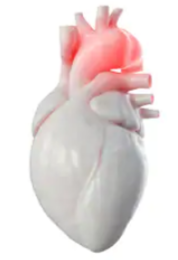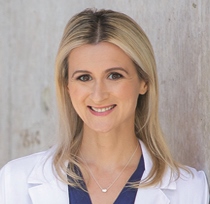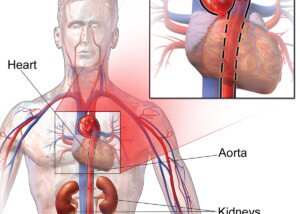Is there a such thing as elective repair of a thoracic aortic aneurysm in patients who find “watchful waiting” too unnerving?
For smaller aneurysms that don’t meet the criteria for surgery (at least 5.5 cm or symptomatic), the patient must undergo indefinite “watchful waiting” and CT scans to monitor expansion rate.
- A TAA doesn’t have to reach 5.5 cm in order to rupture.
- But the greater the diameter, the greater the risk of dissection.
Smaller aneurysms can rupture from a spike in blood pressure caused by physical straining, giving birth or even highly charged emotions. And also for no apparent reason.
Patients who don’t qualify for repair must adhere to lifting restrictions, and this blow is greatest for those who do weight workouts.
Some physicians will warn not to lift even 30 pounds. This means they shouldn’t pick up a preschooler or a big bag of dog food.
Who can live like this? For some people, it would be living on an indefinite disability list – always having to worry about not lifting more than 25 or 30 pounds.
This can mean severe anxiety when helping an elderly family member transfer from bed to chair.
It’s a pretty stressful life when you must always be on the lookout for any other situations that can raise blood pressure such as a burst of anger and even straining during a bowel movement.
As one man in an online forum says:
“You can watch and watch but how can you know when to go to the emergency room? We can’t go running for a CT scan for every chest pain. It’s an entirely subjective trigger, and if you get it wrong you die.”
- It would be an “I can’t do this; I can’t do that” way of life.
- They’d feel so limited.
- Every little chest discomfort would trigger a bleak “what if” thought stream.
So why isn’t elective TAA repair offered to otherwise healthy, nonsmoking people with no comorbidities?
Prophylactic Repair of a Diseased Aorta

Thoracic aortic aneurysm. Shutterstock/Sebastian Kaulitzki
Aneurysms in the descending portion of the aorta are typically repaired endovascularly, while those in the ascending area are typically repaired via open surgery (endovascular repair in this region is still nonconventional because this location does not have a good “landing zone” for the stent graft).
“This comes down to a risk-benefit analysis,” begins Alexandra Kharazi, MD, a cardiothoracic surgeon with CVTS Medical Group, Inc., Chula Vista, CA.
“Surgery and stent grafting is not without its risks. Stent grafts can get endo leaks [of blood] — depending on the hemodynamic forces, not to mention issues like stent graft recalls.”
As mentioned, endovascular repair is the standard procedure for aneurysms in the descending aorta.
The surgeon inserts graft components through the interior of an access vessel and guides this delivery sheath and its materials to the aorta. The stent graft is then deployed and set in place.
But once in place, there’s no guarantee it’ll stay in place. It may shift position or “migrate,” no longer protecting the aneurysm.
Open heart surgery is the standard approach to repairing an aneurysm in the ascending aorta.
“Surgery can develop leaks at the anastomosis (suture line) site, necessitating redo surgery,” says Dr. Kharazi.
“An example of this would be a healthy weightlifter with an asymptomatic 4.5 cm ascending aneurysm getting surgery, then getting a suture line leak as he/she is getting back into training due to a blood pressure spike.
“Now this person must suffer the major morbidity of redo surgery, whereas, statistically speaking, it would have been fine with no intervention.
“This is why blood pressure control is still important post-intervention.”
There’s just too many potential complications to justify elective repair of TAA’s in the name of eliminating the patient’s anxiety.
“Data shows that medical management of small asymptomatic aneurysms that are not growing on CT has great outcomes,” says Dr. Kharazi.
Risk of an Aortic Dissection While Living in “Watchful Waiting” Mode
“The risk of a dissection in aneurysms under 5.0 cm varies from patient to patient,” says Dr. Kharazi.
“The fitter and healthier the patient, the less likely there’ll be a rupture during physical exertion,” such as lifting a 40 pound bag of dog food from the car trunk or picking up one’s injured 70-pound child, carrying them to the car and then setting them inside.
There is lack of numerical data on the likelihood of an aortic dissection in people who have seriously modified their lifestyle to minimize the risk of such an event – as well as people who have only minimally, if at all, modified their lifestyle.
In particular, data is lacking in patients who regularly strength train at a gym or perform physical labor on the job such as in construction or warehouse work.
Having an aortic aneurysm certainly doesn’t mean that training with weights is off-limits, but, once the patient has been diagnosed, they need to forever work out differently and apply lifting restrictions also to the workplace and everywhere else to avoid abrupt climbs in blood pressure.
When I was a personal trainer at a gym, one of my clients had Marfan syndrome, a congenital connective tissue disease that often leads to a thoracic aortic aneurysm.
He told me that he had orders to avoid any straining while lifting.
However, I had him doing typical strength training exercises such as the lat pull-down and other movements with weight stack machines, making a point to set the resistance so that he could carry out the set and feel that he was working, yet not straining or feeling taxed as he progressed through the sets.
People without Marfan syndrome but who have a TAA still need to take precautions – and accept the fact that there’s no such thing as a prophylactic surgical repair of this condition.
- Don’t smoke.
- Follow your doctor’s orders regarding sodium/salt intake.
- Get regular cardiovascular and resistance exercise, adhering to your doctor’s guidelines.
- Manage your stress levels; avoid angry outbursts; pick your battles very carefully; stay away from stressful environments whenever you can.
 Dr. Kharazi has many areas of surgical expertise including the following: aortic aneurysm repair, aortic valve repair and replacement, and CABG. Other areas of focus include arrhythmia, bloodless medicine, lung cancer and resection, septal defect repair and thoracic surgery.
Dr. Kharazi has many areas of surgical expertise including the following: aortic aneurysm repair, aortic valve repair and replacement, and CABG. Other areas of focus include arrhythmia, bloodless medicine, lung cancer and resection, septal defect repair and thoracic surgery.
 Lorra Garrick has been covering medical, fitness and cybersecurity topics for many years, having written thousands of articles for print magazines and websites, including as a ghostwriter. She’s also a former ACE-certified personal trainer.
Lorra Garrick has been covering medical, fitness and cybersecurity topics for many years, having written thousands of articles for print magazines and websites, including as a ghostwriter. She’s also a former ACE-certified personal trainer.
.










































